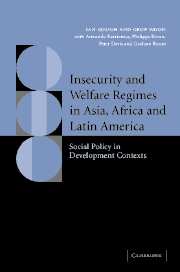 Insecurity and Welfare Regimes in Asia, Africa and Latin America
Insecurity and Welfare Regimes in Asia, Africa and Latin America Book contents
- Frontmatter
- Contents
- List of maps
- List of figures
- List of tables
- List of authors
- Acknowledgements
- List of abbreviations
- Glossary
- Introduction
- Part I Understanding insecurity and welfare regimes in the South: an analytical framework
- Part II Regional regimes
- 4 Latin America : towards a liberal-informal welfare regime
- 5 East Asia : the limits of productivist regimes
- 6 The dynamics of Africa's in/security regimes
- Part III Regimes in global context
- Conclusion : Rethinking social policy in development contexts
- References
- Index
5 - East Asia : the limits of productivist regimes
Published online by Cambridge University Press: 04 August 2010
- Frontmatter
- Contents
- List of maps
- List of figures
- List of tables
- List of authors
- Acknowledgements
- List of abbreviations
- Glossary
- Introduction
- Part I Understanding insecurity and welfare regimes in the South: an analytical framework
- Part II Regional regimes
- 4 Latin America : towards a liberal-informal welfare regime
- 5 East Asia : the limits of productivist regimes
- 6 The dynamics of Africa's in/security regimes
- Part III Regimes in global context
- Conclusion : Rethinking social policy in development contexts
- References
- Index
Summary
Introduction
Benedict Anderson identifies a common post-war pattern of development in the ‘long strip of coastal capitalist states stretching down from South Korea to the eastern edge of the Indian Ocean’ (Anderson 1998: 300). This definition of East Asia excludes the two regional powers, Japan and China, alongside North Korea. It embraces ASEAN, the Association of Southeast Asian Nations, but leaves Myanmar in limbo, and extends northwards to include South Korea, Taiwan and Hong Kong. The major countries are shown in table 5.1, in order of economic affluence. All the countries, except Thailand, were colonised up to and including the twentieth century but by a variety of different powers: Portugal, Spain, the Netherlands, France, Britain, the US and Japan. The region also encompasses vast differences, from rich Singapore to very poor Laos and Cambodia – country variations wider than those in any other part of the world. To make our task manageable, this chapter will ignore the richest – the city-states of Singapore and Hong Kong – and the poorest – the newly emerging economies of Vietnam, Cambodia and Laos. The remaining group are all classified by the World Bank as ‘middle income’, though Indonesia hovers on the borderline of low-income countries.
Within this group, I concentrate on five countries: Indonesia, South Korea, Malaysia, the Philippines and Thailand. These are of interest for three reasons. They have all been participants in the ‘East Asian miracle’ and beneficiaries of the alleged benefits of economic openness and market-friendly policies (World Bank 1993).
- Type
- Chapter
- Information
- Insecurity and Welfare Regimes in Asia, Africa and Latin AmericaSocial Policy in Development Contexts, pp. 169 - 201Publisher: Cambridge University PressPrint publication year: 2004
- 67
- Cited by


